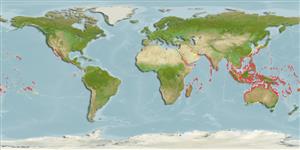Common names from other countries
Classification / Names / Names
Namen | Synonyme | Catalog of Fishes (gen., sp.) | ITIS | CoL | WoRMS
Environment: milieu / climate zone / depth range / distribution range
Ökologie
; tiefenbereich 0 - 25 m (Ref. 348), usually 0 - 25 m (Ref. 75831). Tropical
Indo-Pacific: from East Africa, to eastern Polynesia; north to Japan and Hawaii, and south to Queensland.
Length at first maturity / Size / Gewicht / Alter
Maturity: Lm ? range ? - ? cm Max length : 9.0 cm SHL Männchen/unbestimmt; (Ref. 348); common length : 7.5 cm SHL Männchen/unbestimmt; (Ref. 348)
Locally collected for food in the area (Ref. 348). Found in intertidal areas in sand and mud (Ref. 75831). Also in sublittoral zone (Ref. 345).
Life cycle and mating behavior
Geschlechtsreife | Fortpflanzung | Ablaichen | Eier | Fecundity | Larven
Members of the class Bivalvia are mostly gonochoric, some are protandric hermaphrodites. Life cycle: Embryos develop into free-swimming trocophore larvae, succeeded by the bivalve veliger, resembling a miniature clam.
Poutiers, J.M. 1998. (Ref. 348)
IUCN Rote Liste Status (Ref. 130435)
CITES Status (Ref. 108899)
Not Evaluated
Not Evaluated
Bedrohung für Menschen
Harmless
Nutzung durch Menschen
| FishSource |
Tools
Internet Quellen
Estimates based on models
Preferred temperature
(Ref.
115969): 24.3 - 29.1, mean 28 (based on 1594 cells).
Verwundbarkeit
Low vulnerability (10 of 100).
